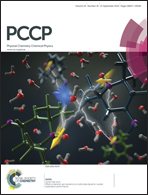Interfacial reactivity of ruthenium nanoparticles protected by ferrocenecarboxylates†
Abstract
Stable ruthenium nanoparticles protected by ferrocenecarboxylates (RuFCA) were synthesized by thermolytic reduction of RuCl3 in 1,2-propanediol. The resulting particles exhibited an average core diameter of 1.22 ± 0.23 nm, as determined by TEM measurements. FTIR and 1H NMR spectroscopic measurements showed that the ligands were bound onto the nanoparticle surface via Ru–O bonds in a bidentate configuration. XPS measurements exhibited a rather apparent positive shift of the Fe2p binding energy when the ligands were bound on the nanoparticle surface, which was ascribed to the formation of highly polarized Ru–O interfacial bonds that diminished the electron density of the iron centers. Consistent results were obtained in electrochemical measurements where the formal potential of the nanoparticle-bound ferrocenyl moieties was found to increase by ca. 120 mV. Interestingly, galvanic exchange reactions of the RuFCA nanoparticles with Pd(II) followed by hydrothermal treatment at 200 °C led to (partial) decarboxylation of the ligands such that the ferrocenyl moieties were now directly bonded to the metal surface, as manifested in voltammetric measurements that suggested intervalence charge transfer between the nanoparticle-bound ferrocene groups.


 Please wait while we load your content...
Please wait while we load your content...